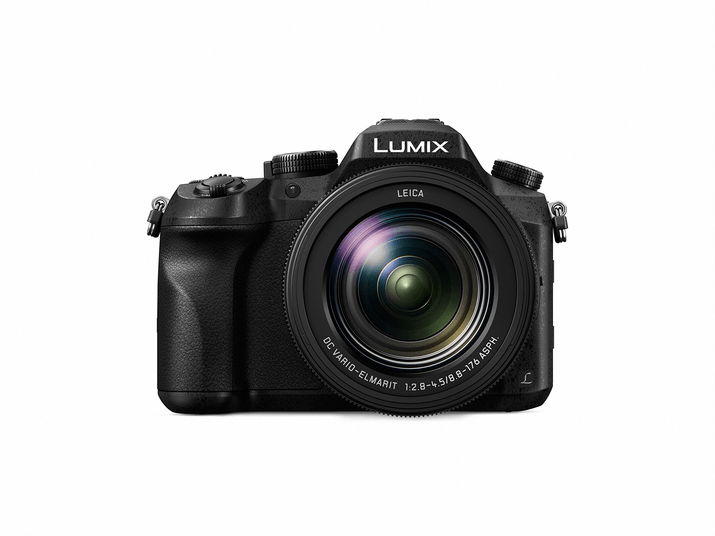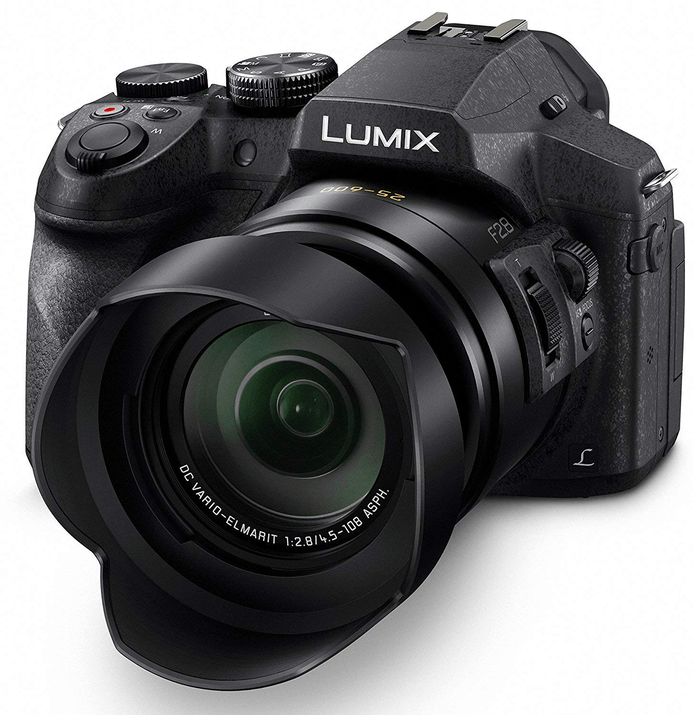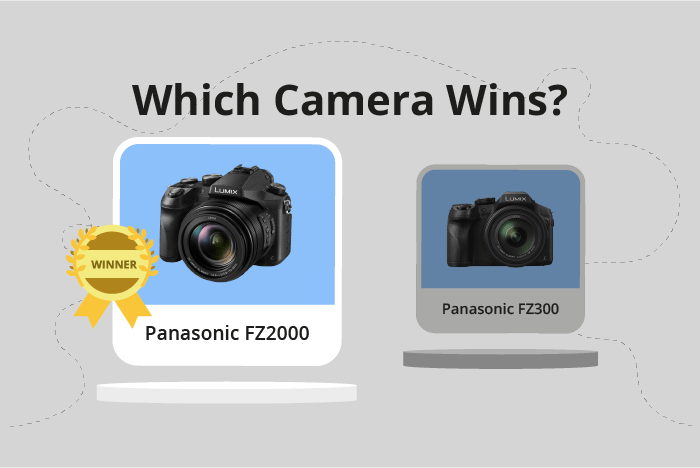Panasonic Lumix DMC-FZ2000 / FZ2500 vs Lumix FZ300 / FZ330 Comparison
Panasonic Lumix DMC-FZ2000 / FZ2500

Panasonic Lumix FZ300 / FZ330

The Panasonic Lumix DMC-FZ2000 / FZ2500 outperforms the Panasonic Lumix FZ300 / FZ330 with a score of 63/100 compared to 54/100. Both cameras share the same camera type, Bridge, and were released in 2016 and 2015, respectively. The FZ2000 / FZ2500 boasts a larger size (138 x 102 x 135mm) and heavier weight (915g / 2.02lbs), which can be seen as an advantage for better stability and handling. However, the FZ300 / FZ330 is more compact (132 x 92 x 117mm) and lighter (691g / 1.52lbs), making it a more portable option. Despite the higher launch price of $1199 for the FZ2000 / FZ2500 compared to $600 for the FZ300 / FZ330, its superior score justifies the difference.
Panasonic Lumix DMC-FZ2000 / FZ2500 vs Lumix FZ300 / FZ330 Overview and Optics
The Panasonic Lumix DMC-FZ2000 / FZ2500 outperforms the Panasonic Lumix FZ300 / FZ330 in optics with a score of 62/100 compared to 49/100. Both cameras have common specifications, such as a CMOS sensor, Venus Engine processor, a fixed lens mount, image stabilization, and a shooting speed of 12 frames per second.
The FZ2000 / FZ2500 excels in several areas. It has a higher megapixel count of 20, which contributes to better image resolution. Additionally, its sensor size is 1″, which is larger than the FZ300 / FZ330’s 1/2.3″ sensor. A larger sensor size generally results in improved image quality, especially in low light conditions. The FZ2000 / FZ2500 also boasts a higher DXOMARK score for its sensor at 70, further confirming its superior image quality. The aspect ratio of 3:2 is more versatile for different types of photography.
On the other hand, the FZ300 / FZ330 has a few advantages. Despite its lower megapixel count of 12, it still provides decent image quality. Its aspect ratio of 4:3 is well-suited for specific photography styles, such as portraits and landscapes.
Considering the differences in optics, the Panasonic Lumix DMC-FZ2000 / FZ2500 is the clear winner with better image quality, a larger sensor, and a higher DXOMARK score. However, the Panasonic Lumix FZ300 / FZ330 remains a viable option for those who prefer a specific aspect ratio and do not require the highest possible image resolution.
Panasonic Lumix DMC-FZ2000 / FZ2500 vs Lumix FZ300 / FZ330 Video Performance
The Panasonic Lumix DMC-FZ2000 / FZ2500 and the Panasonic Lumix FZ300 / FZ330 both received a video score of 69/100, indicating that they share similar video capabilities. Both cameras have a maximum video resolution of 4K and a maximum video frame rate of 60fps. Neither camera has built-in time-lapse functionality.
Despite the same video scores, the FZ2000 / FZ2500 has a slight advantage due to its higher maximum video dimensions of 4096 x 2160, compared to the FZ300 / FZ330’s 3840 x 2160. This means that the FZ2000 / FZ2500 can produce slightly larger and more detailed video footage. However, the difference in dimensions is not significant and may not be noticeable to the average user.
On the other hand, the FZ300 / FZ330 does not have any clear advantages over the FZ2000 / FZ2500 in terms of video capabilities. Both cameras share the same core specifications, such as 4K resolution and 60fps frame rate. This suggests that users can expect similar video performance from both models.
In comparing the video capabilities of the Panasonic Lumix DMC-FZ2000 / FZ2500 and the Panasonic Lumix FZ300 / FZ330, it is evident that both cameras offer similar features and performance. The FZ2000 / FZ2500 has a slight edge with its larger maximum video dimensions, while the FZ300 / FZ330 does not possess any distinct advantages. Users can expect comparable video quality from both cameras, with the FZ2000 / FZ2500 potentially offering marginally better detail in its footage.
Panasonic Lumix DMC-FZ2000 / FZ2500 vs Lumix FZ300 / FZ330 Features and Benefits
The Panasonic Lumix DMC-FZ2000 / FZ2500 and the Panasonic Lumix FZ300 / FZ330 both have a feature score of 70/100. These cameras share several common specifications, making it a close competition.
Both cameras have a 3-inch screen size and a screen resolution of 1,040,000 dots. They also both have touchscreens and flip screens, making them user-friendly and versatile in various shooting situations. Neither camera has GPS capabilities, but both have Wi-Fi functionality for easy photo sharing and remote control.
The Lumix DMC-FZ2000 / FZ2500 stands out with its Bluetooth connectivity, which the Lumix FZ300 / FZ330 lacks. This feature allows the FZ2000 / FZ2500 to connect to other devices seamlessly and transfer files wirelessly, making it more convenient for users.
On the other hand, the Lumix FZ300 / FZ330 does not have any clear advantages over the Lumix DMC-FZ2000 / FZ2500 in terms of features. Both cameras are evenly matched, with the FZ2000 / FZ2500 having the slight edge due to its Bluetooth connectivity.
When comparing the Panasonic Lumix DMC-FZ2000 / FZ2500 and the Panasonic Lumix FZ300 / FZ330, it is clear that the FZ2000 / FZ2500 has a slight advantage with its added Bluetooth feature. However, both cameras share many similar specifications, making them both suitable choices for users seeking a versatile and user-friendly camera. The Bluetooth feature may be a deciding factor for some users, but overall, both cameras offer excellent features and performance.
Panasonic Lumix DMC-FZ2000 / FZ2500 vs Lumix FZ300 / FZ330 Storage and Battery
The Panasonic Lumix DMC-FZ2000 / FZ2500 and the Panasonic Lumix FZ300 / FZ330 share an equal storage and battery score of 35/100. Both cameras have one memory card slot, accepting SD, SDHC, and SDXC cards. Additionally, both cameras offer USB charging capabilities.
The FZ2000 / FZ2500 has a battery life of 350 shots, using the DMW-BLC12 battery type. In comparison, the FZ300 / FZ330 has a slightly longer battery life of 380 shots, with a lithium-ion battery. This advantage provides a more extended shooting time for the FZ300 / FZ330 users.
Despite the difference in battery life, both cameras maintain equal scores as they share similar storage and charging features. Users should consider this aspect when choosing between the two cameras, with the FZ300 / FZ330 offering a minor advantage in battery life.
Panasonic Lumix DMC-FZ2000 / FZ2500 vs Lumix FZ300 / FZ330 – Our Verdict
Are you still undecided about which camera is right for you? Have a look at these popular comparisons that feature the Panasonic Lumix DMC-FZ2000 / FZ2500 or the Panasonic Lumix FZ300 / FZ330:
- Panasonic Lumix DMC-FZ1000 II vs Lumix DMC-FZ2000 / FZ2500
- Panasonic Lumix FZ300 / FZ330 vs Lumix FZ80 / FZ82
- Panasonic Lumix DMC-FZ2000 / FZ2500 vs Lumix FZ80 / FZ82
- Canon PowerShot SX70 HS vs Panasonic Lumix DMC-FZ2000 / FZ2500
- Nikon Coolpix P950 vs Panasonic Lumix DMC-FZ2000 / FZ2500
- Panasonic Lumix DMC-FZ2000 / FZ2500 vs Sony Cyber-shot RX10 IV

